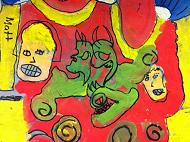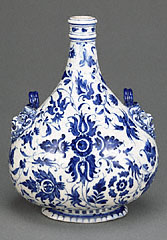Grades/Level: Lower Elementary (K–2), Upper Elementary (3–5) |
|
|||||||||||||||||||||||||||||||||||||||||||||||||||||
Lesson Overview |
|
|||||||||||||||||||||||||||||||||||||||||||||||||||||
Students will discuss works of art that have grotesque elements and symmetry in their design. They will identify symmetry and line in grotesques. Students will create symmetrical designs for a pilgrim bottle and also design a door panel using grotesques. They will then analyze William Blake's poem "The Tiger" and write their own grotesque-inspired poetry. |
||||||||||||||||||||||||||||||||||||||||||||||||||||||
Learning Objectives |
||||||||||||||||||||||||||||||||||||||||||||||||||||||
Students will be able to:
|
||||||||||||||||||||||||||||||||||||||||||||||||||||||
Materials |
||||||||||||||||||||||||||||||||||||||||||||||||||||||
• Image of Pilgrim Flask by the Medici Porcelain Manufactory |
||||||||||||||||||||||||||||||||||||||||||||||||||||||
|
||||||||||||||||||||||||||||||||||||||||||||||||||||||
Lesson Steps |
||||||||||||||||||||||||||||||||||||||||||||||||||||||
Part 1: The Pilgrim Flask
2. After the class discussion, provide students with information about the object. Explain to them that this pilgrim flask is a rare and valuable object that has a shape similar to containers that pilgrims and travelers used for carrying water in Europe during the Middle Ages. However, this flask was used for display and decoration, not for traveling! 3. Using the image of the Pilgrim Flask, explain to students that the object's design features "grotesques." Discuss the notion of this work of art as both pretty and ugly. Ask students:
4. Tell students that grotesque designs combine ugly and beautiful elements—scrolling lines, plants, and unnatural humans and animals. Designs might include chimeras (creatures that are a mixture, or hybrid, of animals, plants, humans, and other objects), small flowers and plants, and expressive but often distorted faces. Consolidate this information about grotesque designs onto a chart titled "Elements of the Grotesque." 5. Show students an image of a detail of the Pilgrim Flask. First have students identify the kinds of lines they see (as they did in Step 1). Then point out the symmetrical elements on the Pilgrim Flask and introduce the vocabulary terms symmetry and asymmetry. Symmetry occurs when the same lines, shapes, or patterns exist on opposite sides of a dividing line. Asymmetry is the opposite of symmetry, occurring when lines, shapes, and patterns do not correspond on either side of a dividing line. Ask students the following questions:
6. Inform students that they will create a design for a pilgrim bottle using symmetrical elements and grotesques. 7. Pass out pencils and blue crayons, along with the student handout "Pilgrim Bottle Template." 8. Tell students to sketch their design on the "Pilgrim Bottle Template" (reminding them to draw a dividing line between any symmetrical element). Allow students ample time to create symmetrical designs and grotesques on their pilgrim bottles. Part 2: The Paneled Room 1. Display an image of the Paneled Room by Claude-Nicolas Ledoux, Jean-Siméon Rousseau de la Rottière, and Jules-Hugues Rousseau. Encourage students to look carefully at the image and share their initial observations. Ask students the following questions:
2. Show students the image of the Paneled Room: Door, a detail of the Paneled Room. Ask students the following questions:
3. Review the chart "Elements of the Grotesque" from Part 1. If students have additional observations after looking at the Paneled Room, add as necessary. 4. Divide students into working groups. Tell students they are going to design grotesques on a panel, in the same style as the door design in the Paneled Room. Remind them to use symmetry in their designs. 5. Distribute copies of the student handout "Door Panel Template" and have students begin sketching their designs. 6. When students have completed their sketches, pass out a large "panel" of butcher paper to each working group. Prompt each group to transfer their design onto their large panel of butcher paper. 7. Next, pass out the paint brushes and paint to the student groups. 8. Instruct students to paint the details of their design that they have sketched on the butcher paper. When the panels are finished and dried, hang all of the panels on a classroom wall to simulate a new "paneled room." Part 3: The Grotesque in Poetry 1. Point out to students that writers also include beautiful and ugly elements in their works, just artists have done with grotesques. Chart and read the poem "The Tiger" by William Blake to the class (see the Bartleby web page). After reading the poem, introduce the vocabulary words repel and attract. Explain that attract means to pull toward (like a magnet), and repel means to push away. Tell students that a writer might include beautiful or happy words to attract readers, or ugly or terrifying words to repel readers. 2. Ask the students which words or phrases in the poem repel them as readers and which words or phrases in the poem attract them as readers. Underline the phrases that repel them in red and phrases that attract them in green. 3. Pass out the paper for writing. 4. Show students an image of a flower or something considered beautiful. Tell students to write a short sentence about the flower using terrifying or ugly words. Let students share their sentences with the class. 5. Next, show students an ugly or sad image. Prompt students to write a sentence about the image using beautiful or happy language. 6. Introduce the word contradiction. Explain to students that a contradiction is two ideas opposing each other (e.g., being attracted to something ugly or being repelled by something beautiful). Give students time to discuss as a class how writing in contradictions makes them feel. Part 4: Writing Grotesque Poetry 1. Review with students the images of the Pilgrim Flask and the Paneled Door. Also review the poem "The Tiger" by William Blake and the chart "Elements of the Grotesque." 2. Tell students to each select an object to use as the subject and inspiration for their own "contradiction poem." (Students may choose to follow a similar style as Blake's, selecting a creature to describe, address, and question.) 3. Have students write their poems. Encourage them to look at the "Elements of the Grotesque" chart and incorporate at least one element in their poems. Give students time to revise their poetry as needed. |
|
|||||||||||||||||||||||||||||||||||||||||||||||||||||
Assessment |
||||||||||||||||||||||||||||||||||||||||||||||||||||||
Students will be assessed on: |
||||||||||||||||||||||||||||||||||||||||||||||||||||||
Extensions |
||||||||||||||||||||||||||||||||||||||||||||||||||||||
As an extension, allow students to read their poetry in the "paneled room" classroom. Invite family and friends. |
||||||||||||||||||||||||||||||||||||||||||||||||||||||
Standards Addressed |
||||||||||||||||||||||||||||||||||||||||||||||||||||||
Common Core Standards for English Language Arts |
|
|||||||||||||||||||||||||||||||||||||||||||||||||||||







